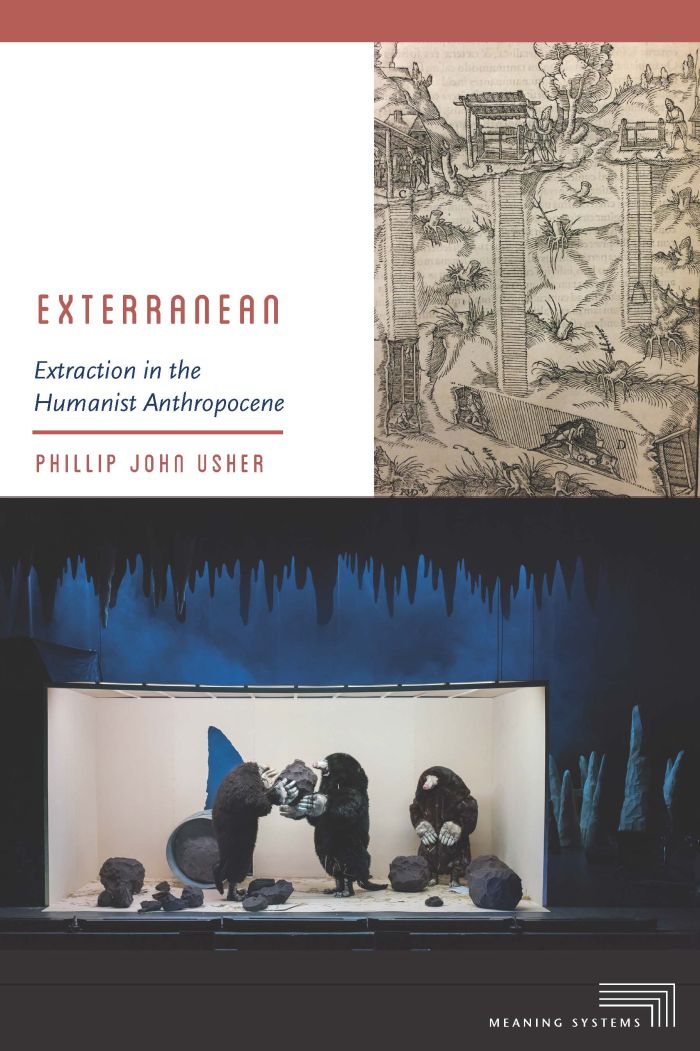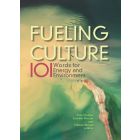Exterranean
Extraction in the Humanist Anthropocene

This book can be opened with

Exterranean concerns the extraction of stuff from the Earth, a process in which matter goes from being sub- to exterranean. By opening up a rich archive of nonmodern texts and images from across Europe, this work offers a bracing riposte to several critical trends in ecological thought.
By shifting emphasis from emission to extraction, Usher reorients our perspective away from Earthrise-like globes and shows what is gained by opening the planet to depths within. The book thus maps the material and immaterial connections between the Earth from which we extract, the human and nonhuman agents of extraction, and the extracted matter with which we live daily.
Eschewing the self-congratulatory claims of posthumanism, Usher instead elaborates a productive tension between the materially-situated homo of nonmodern humanism and the abstract and aggregated anthropos of the Anthropocene. In dialogue with Michel Serres, Bruno Latour, and other interdisciplinary work in the environmental humanities, Usher shows what premodern material can offer to contemporary theory. Examining textual and visual culture alike, Usher explores works by Ronsard, Montaigne, and Rabelais, early scientific works by Paracelsus and others, as well as objects, engravings, buildings, and the Salt Mines of Wieliczka. Both historicist and speculative in approach, Exterranean lays the groundwork for a comparative ecocriticism that reaches across and untranslates theoretical affordances between periods and languages.
For anyone who might be suffering from Anthropocene fatigue, this is a book to jolt you from your slumbers. What happens to the globe when we shift attention from the outward projection of emissions to extraction ? The earth we thought we knew, and were already mourning, takes on a stunning new critical light.—Claire Colebrook, Pennsylvania State University
Usher’s brilliant study is a richly argued, erudite yet lyrical ode to the stuff of which the Earth is made. Exterranean engages with the record of human earthly entanglements in early modern European humanism, but always with a view to counterbalancing current distancing and idealizing views of a globe that is all surface, and no depth. By channeling the voices and agencies of Earth’s nonhuman subterranean elements in all their omnipresent intimacy, Usher thus reconnects us not merely to the history of knowledge and beliefs about the Earth and its contents, but to our own fragile planet.—Karen Raber, University of Mississippi
True to its title, Exterranean is groundbreaking: a book that will shape and generate scholarly discussion for years to come.—Renaissance Quarterly
...Usher's lyrical, extensively footnoted study is an important addition to Anthropocene scholarship. Highly recommended.—Choice
In each of his chapters, Usher presents careful readings and explications of poems and texts—some forgotten, some famous but now read in another vein—gradually building up a tissue of connections across a veritable culture of extraction, yes, but more, a material culture that stands at the beginning of a teasing out of the values, difficulties, and ecological consequences of the processes that in turn came to form our own Anthropocene. In doing so, he also charges us to return to those texts of the well-worn Renaissance, to the quarrying and mining of that era’s building materials, to the labors and desolation incurred, and to the mythical and real powers that extraction invoked.—Anthony Vidler, Journal of the Society of Architectural Historians
Exterranean is an excellent study because it offers a descent into the non-anthropological worlds of extraction along with further avenues of research into, among other things, the politics of the exterranean.—Antónia Szabari, French Forum
List of Figures . . . . . . . . . . . . . . . . . . . . . . . . . . . . . . . .ix
Incipit: From Sub- to Exterranean . . . . . . . . . . . . . . . . 1
I: Terra Global Circus
1. Terra Has Standing . . . . . . . . . . . . . . . . . . . . . . . . . . . 24
2. Terre’s Brilliant Mines . . . . . . . . . . . . . . . . . . . . . . . . 41
3. Terra Globalized . . . . . . . . . . . . . . . . . . . . . . . . . . . . . 57
II: Welcome to Mineland
4. Sickly Mountainsides . . . . . . . . . . . . . . . . . . . . . . . . . 80
5. Demonic Mines . . . . . . . . . . . . . . . . . . . . . . . . . . . . . . 99
III: Hiding in Exterranean Matter
6. Geomedia . . . . . . . . . . . . . . . . . . . . . . . . . . . . . . . . . . 115
7. Saline Intimacies . . . . . . . . . . . . . . . . . . . . . . . . . . . . . 133
Explicit . . . . . . . . . . . . . . . . . . . . . . . . . . . . . . . . . . . . . 151
Acknowledgments . . . . . . . . . . . . . . . . . . . . . . . . . . .157
Notes . . . . . . . . . . . . . . . . . . . . . . . . . . . . . . . . . . . . . .159
Index . . . . . . . . . . . . . . . . . . . . . . . . . . . . . . . . . . . . . .199




